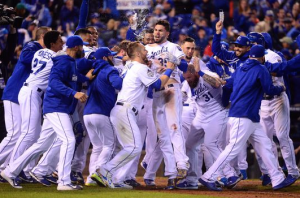Baseball fans wake up for Game 2 of the 2015 World Series with the same feeling the rest of America has after Thanksgiving dinner, because that’s what this series opener was—a long-awaited celebration that was satisfying on so many levels. It unfolded as expected in certain situations, but with enough surprises to create an epic experience, especially from a stats perspective.
Now, let’s look forward to doing it all over again on Wednesday night.
Historically Speaking…
- The New York Mets will attempt to rebound in Game 2, knowing the slim chances they have of overcoming a 2-0 deficit. The 1986 World Series is the only example in franchise history of them losing consecutive games in a postseason series and going on to win it. Anything can happen under these bright lights, but it’s difficult to imagine the nasty Kansas City Royals relievers suffering through that kind of choke job.
- Most of his management career has been mediocre, but Ned Yost is suddenly a dominant force in October. A Game 2 victory would bring his postseason record as a skipper to 20-8, matching how Casey Stengel started his legendary career. Only Joe McCarthy—20 wins in his first 27 postseason games—excelled more from the get-go.
- If we extend into extra innings again, it would be the first time since Games 4 and 5 in 2001 that a World Series goes beyond regulation on back-to-back nights.
- Let’s say Game 2 veers in the opposite direction, with one team routing the other…might we see a position player make World Series history by taking the mound? (h/t to Scott Lindholm for confirming that there’s no precedent) The circumstances are perfect for that kind of novelty, considering the depleted states of both bullpens and limited rest. The Royals have fire-baller Drew Butera at their disposal, while the Mets could lean on Michael Cuddyer’s experience.
What to Watch for
- This season, fastball velocity has been a strong indicator of whether or not Johnny Cueto succeeds or flops in any given start. His highest Game Scores—a 93 on July 7 and a 87 on August 10—came in outings where his four-seamer and sinker both averaged at least 93 mph. The same was true of his ALDS Game 5 masterpiece (8.0 IP, 2 H, 8 K). But when the velocity drops, he’s had trouble generating swinging strikes,. That extends opposing plate appearances and inflates his pitch count in the early innings.
- In Game 1, most of New York’s offense was generated with the put-the-ball-on-the-ground-and-pray-the-BABIP-gods-are-on-your-side strategy. That’s probably their best option in Game 2, as well. Leaning on Kauffman Stadium’s size and the defensive skills of their outfielders, the Royals only allowed a .558 OPS on fly balls during the season (league average was a .590 OPS).
- Ned Yost has shown himself to be a big fan of the sacrifice bunt, and it wouldn’t be a surprise to see him turn to it again versus Jacob deGrom. Swinging for the fences to advance baserunners often ends in disappointment against deGrom, who minimizes solid contact. He ranked 11th-best in MLB this year in limiting the distance of batted balls (min. 300 ABs with batted ball data). There’s also a strong possibility that Terry Collins optimizes his run prevention by starting Juan Lagares in center field.

